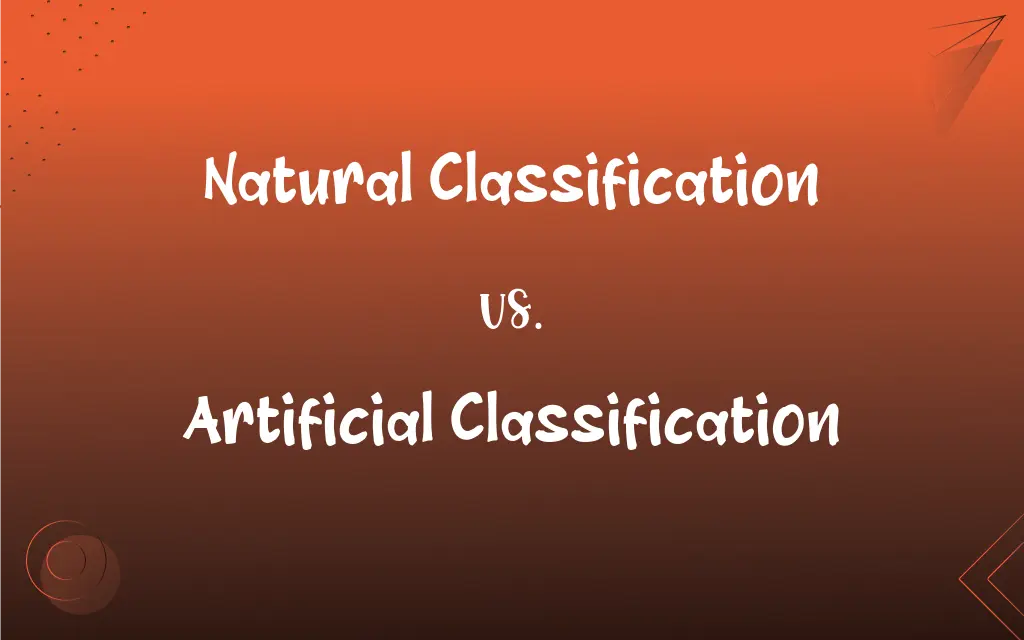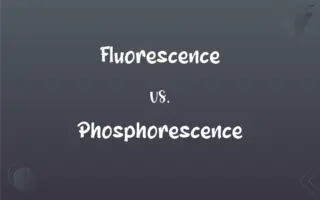Natural Classification vs. Artificial Classification: What's the Difference?
Edited by Aimie Carlson || By Harlon Moss || Updated on October 6, 2023
Natural classification organizes organisms based on evolutionary relationships and genetic similarities, while artificial classification sorts them based on arbitrary, often physical, characteristics without considering evolutionary aspects.

Key Differences
Natural classification underscores an organization strategy for living organisms founded on their evolutionary history and genetic connections. The focus of natural classification gravitates toward aligning entities based on shared biological and genetic traits, embracing a broader view that encapsulates the intrinsic relationships among various organisms. As a result, this approach tends to offer a more holistic and universally relevant categorization method.
Artificial classification, on the contrary, arranges organisms predominantly based on observable or physical traits, frequently neglecting the genetic and evolutionary relationships. This method might prioritize easily distinguishable characteristics, such as color, size, or shape, providing a framework that can be straightforward yet potentially superficial. Consequently, artificial classification may not accurately reflect the deeper biological and evolutionary relationships between organisms.
Natural classification seeks to unveil and honor the authentic, often unseen, relationships between different entities by probing their genetic and evolutionary ties. Conversely, artificial classification adheres predominantly to external, readily identifiable attributes, which might streamline identification but may not offer substantive insight into the deeper, intrinsic links among organisms.
The validity and acceptance of natural classification typically resonate more within scientific communities due to its effort to illuminate the phylogenetic relationships among entities. Whereas artificial classification may find its utility in specific, perhaps more practical or immediate, contexts wherein rapid or simplified classification is requisite, albeit with a potential sacrifice in depth and comprehensiveness.
While natural classification endeavors to be thorough and rooted in substantial biological connections, it can also be complex and resource-intensive. In contrast, artificial classification, although potentially reductive and superficial, might offer pragmatism and expedience in particular scenarios, emphasizing that each approach possesses its own set of strengths and limitations.
ADVERTISEMENT
Comparison Chart
Basis of Classification
Based on genetic and evolutionary similarities among organisms.
Based on observable and often physical characteristics.
Depth of Information
Provides deeper, evolutionary information about organisms.
May lack depth regarding evolutionary connections.
Complexity
Tends to be more complex and detailed.
Generally simpler, focusing on easily observable traits.
Scientific Relevance
Widely accepted and utilized in scientific contexts.
May be less relevant in scientific studies of relationships.
Ease of Identification
May require more specialized knowledge for accurate identification.
Enables easier and quicker identification of organisms.
ADVERTISEMENT
Natural Classification and Artificial Classification Definitions
Natural Classification
This approach tends to be favored in scientific contexts for its provision of in-depth, evolutionary insights.
The natural classification of bacterial strains reveals a more intricate picture of their development and diversification over time.
Artificial Classification
Artificial classification organizes organisms based on observable physical traits, irrespective of evolutionary relationships.
Botanists sometimes use artificial classification to quickly categorize plants based on leaf shapes during field studies.
Natural Classification
Natural classification categorizes organisms based on their inherent genetic and evolutionary relationships.
Biologists favor natural classification as it showcases the evolutionary pathway of organisms, reflecting genuine biological connections.
Artificial Classification
Artificial classification can offer a straightforward and accessible means to categorize, albeit possibly at a superficial level.
In certain educational settings, artificial classification can facilitate student learning by grouping animals based on observable features like number of legs.
Natural Classification
Natural classification often necessitates a thorough understanding of an organism’s genetic makeup and evolutionary journey.
Through natural classification, scientists were able to elucidate the shared ancestry of mammals, highlighting underlying genetic commonalities.
Artificial Classification
It is an approach that may prioritize human utility or simplicity, potentially sacrificing biological or evolutionary accuracy.
Through artificial classification, gardeners might group plants based on their utility in cooking, rather than their genetic affiliations.
Natural Classification
It’s a system that strives to group entities considering their phylogenetic relationships and ancestral ties.
The natural classification of plants brings forth a coherent map of species evolution, tracing shared ancestry and divergence.
Artificial Classification
Artificial classification tends to prioritize ease and practicality, focusing on immediate, discernible attributes.
For rapid sorting of insect specimens, researchers might apply artificial classification, leveraging visually apparent wing patterns.
Natural Classification
Natural classification aims to reflect true biological and evolutionary lineages among organisms.
Employing natural classification, the taxonomist illuminated the detailed evolutionary trajectories of different fungal species, unearthing their interconnected lineages.
Artificial Classification
It's a system that places entities into groups using select, often superficial, characteristics.
Artificial classification was employed in early botany, utilizing features like flower color for categorizing various species.
FAQs
What is natural classification?
Natural classification arranges organisms based on genetic and evolutionary similarities.
In what contexts might artificial classification be disadvantageous?
In scientific research, where understanding genetic and evolutionary relationships is crucial, artificial classification might be limiting or misleading.
How does natural classification impact scientific research?
It allows scientists to understand the evolutionary development and genetic relationships between organisms, aiding in studies of phylogeny and speciation.
Can artificial classification be useful in day-to-day scenarios?
Yes, it can simplify identification and categorization in practical, non-scientific contexts, such as organizing plants in gardening.
Is natural classification more widely accepted in scientific contexts than artificial classification?
Generally, yes, due to its incorporation of evolutionary and genetic data.
Does artificial classification consider genetic similarities?
Typically, no. It prioritizes physical traits over genetic or evolutionary considerations.
What is artificial classification?
Artificial classification organizes organisms according to observable, physical characteristics without considering evolutionary relationships.
In what scenarios might artificial classification be preferred?
It may be preferred in scenarios requiring rapid or simplified categorization, such as initial field sorting or educational demonstrations.
Are physical traits irrelevant in natural classification?
No, physical traits are considered but are contextualized within an evolutionary framework.
Does natural classification contribute to the development of phylogenetic trees?
Yes, it aids in constructing phylogenetic trees by revealing evolutionary relationships among organisms.
Can artificial classification lead to misgrouping of organisms?
Potentially, yes, as it may not account for underlying genetic disparities among similarly appearing entities.
Can artificial and natural classification systems coexist?
Yes, both can be used depending on the context and the purpose of the classification.
What are the limitations of artificial classification?
It may oversimplify or inaccurately group organisms by not accounting for genetic and evolutionary distinctions.
Are there hybrid classification systems that utilize both natural and artificial methods?
Yes, hybrid approaches can leverage both observable traits and genetic data, depending on the application.
Can artificial classification be useful for laypeople?
Yes, it might provide a straightforward way for non-experts to identify and categorize organisms.
How does technology impact natural classification?
Technology, especially genetic sequencing, greatly enhances the precision and depth of natural classification by revealing genomic data.
What kind of traits does natural classification examine?
It examines traits derived from the genetic and evolutionary history of the organisms.
Is artificial classification always superficial?
While it focuses on observable traits, it can provide pragmatic categorization, but may lack depth in biological contexts.
Why is natural classification important?
It provides insights into the evolutionary relationships and genetic commonalities among organisms.
How does natural classification support biodiversity studies?
It helps understand evolutionary pathways, speciation, and relationships among diverse organisms, underpinning biodiversity research.
About Author
Written by
Harlon MossHarlon is a seasoned quality moderator and accomplished content writer for Difference Wiki. An alumnus of the prestigious University of California, he earned his degree in Computer Science. Leveraging his academic background, Harlon brings a meticulous and informed perspective to his work, ensuring content accuracy and excellence.
Edited by
Aimie CarlsonAimie Carlson, holding a master's degree in English literature, is a fervent English language enthusiast. She lends her writing talents to Difference Wiki, a prominent website that specializes in comparisons, offering readers insightful analyses that both captivate and inform.































































